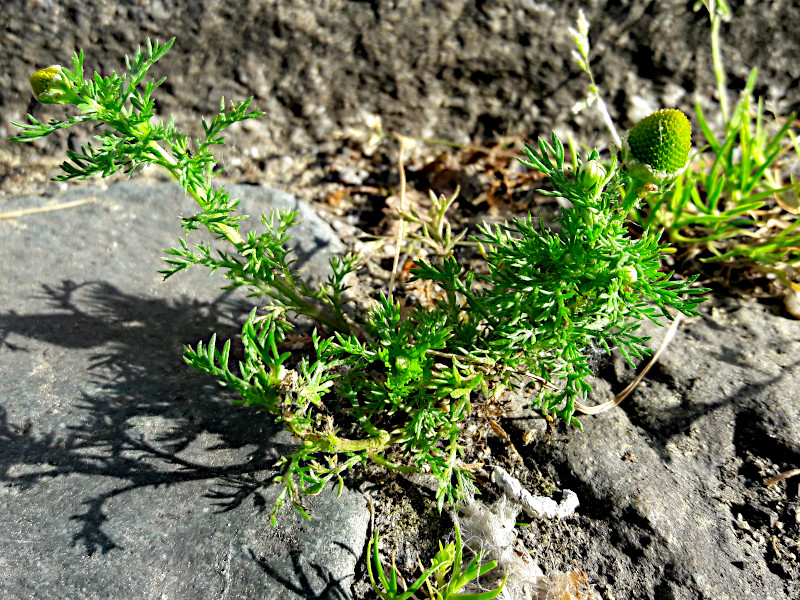Wise Mind Herbs
Evidence-based Herbal Healing
The information on this page has been prepared with reference to published scientific literature, not by a medically qualified expert. It is not medical advice. Any decision to use a supplement or herb-based product is your responsibility. Consult a suitably qualified medical professional, especially if you have underlying conditions. Remember, nothing is for everyone, and not everything sold is what it claims to be. Some things work for some people, some of the time.
Pineapple weed - Matricaria discoidea
Pineapple weed (Matricaria discoidea, syn. Matricaria matricarioides) is a small aromatic annual plant native to North America and East Asia that has naturalized globally. It is commonly known as pineapple weed, wild chamomile, disc mayweed, or rayless chamomile. This plant is often confused with German chamomile (Matricaria chamomilla, syn. Matricaria recutita) due to similar appearance and properties, but they are distinct species. It's also sometimes mistaken for Roman chamomile (Chamaemelum nobile) or scentless mayweed (Tripleurospermum inodorum).

Pharmacological Properties and Active Compounds
Matricaria discoidea contains several bioactive compounds including flavonoids (apigenin, luteolin), essential oils (primarily alpha-bisabolol, chamazulene), sesquiterpene lactones, coumarins, and polyphenols. These compounds are responsible for most of its medicinal properties. The concentration of active compounds varies significantly based on growing conditions, harvest time, and extraction methods, which can influence efficacy in studies and traditional applications.
Evidence-Based Health Benefits
Scientific research on Matricaria discoidea specifically is limited compared to its relative Matricaria chamomilla. Most knowledge comes from ethnobotanical reports, preliminary laboratory studies, and limited clinical trials. The following benefits have varying levels of scientific support:
- Anti-inflammatory properties: In vitro and animal studies suggest modest anti-inflammatory effects attributed to flavonoids and sesquiterpenes.
- Antimicrobial activity: Laboratory studies indicate inhibitory effects against certain bacteria and fungi, potentially useful for minor skin infections.
- Antioxidant effects: Moderate free radical scavenging activity has been observed in chemical assays.
- Digestive aid: Some evidence supports traditional use for gastrointestinal discomfort and mild digestive disorders.
- Mild anxiolytic effects: Preliminary animal studies suggest potential stress-reducing properties, though human studies are lacking.
Conditions with Limited Evidence for Benefit
It's important to note that Matricaria discoidea has not been conclusively proven to "cure" any medical condition. The following applications have preliminary or traditional support but require further research:
- Mild insomnia or sleep disturbances
- Minor skin irritations and inflammations
- Infantile colic (though safety in infants is not well-established)
- Menstrual discomfort
- Mild anxiety and stress
- Gastrointestinal complaints including indigestion and bloating
Recommended Dosages and Preparations
Due to limited clinical research specific to Matricaria discoidea, standardized dosing guidelines are not well-established. Most applications are based on traditional use patterns:
- Tea/infusion: 1-2 teaspoons (2-4 g) of dried flower heads steeped in 8 oz hot water for 10-15 minutes, taken 2-3 times daily.
- Tincture (1:5 in 45% alcohol): 2-4 mL, 2-3 times daily.
- Topical preparations: Creams or ointments containing 3-10% of plant extract applied to affected areas 1-3 times daily.
Standardization is uncommon in commercial products, but when available, products may be standardized to contain 0.3-1.2% apigenin or 0.5-1.5% essential oil content. However, these standards are more commonly applied to German chamomile than specifically to pineapple weed.
Side Effects and Contraindications
While generally considered safe when used appropriately, potential adverse effects include:
- Allergic reactions, particularly in individuals with known sensitivity to plants in the Asteraceae family
- Contact dermatitis in susceptible individuals
- Potential drug interactions with sedatives, anticoagulants, and certain antihypertensive medications
- Cross-reactivity with ragweed allergies
Contraindications include pregnancy (due to insufficient safety data), hormone-sensitive conditions (theoretical concerns due to potential estrogenic effects), and scheduled surgery (due to potential anticoagulant effects).
High-Dose Studies and Knowledge Gaps
There is a significant lack of research investigating high-dose effects of Matricaria discoidea. The few toxicity studies that exist suggest low acute toxicity, but comprehensive studies examining potential adverse effects at doses exceeding traditional use are notably absent. No established maximum tolerated dose has been determined through systematic research. This represents a substantial knowledge gap in the scientific literature. Further research is needed to establish both efficacy at standard doses and safety profiles at higher doses.
Commercial Pharmaceutical Products
Unlike German chamomile (Matricaria chamomilla), which is incorporated into several pharmaceutical formulations, there are currently no major pharmaceutical products specifically featuring standardized Matricaria discoidea extracts or compounds. Most commercial applications are limited to herbal supplements, teas, and topical preparations that are not regulated as pharmaceutical drugs. Some herbal combination products may include pineapple weed, but these are typically marketed as dietary supplements rather than pharmaceutical medicines with therapeutic claims.
Research Limitations and Future Directions
The current body of research on Matricaria discoidea has several limitations, including small sample sizes, methodological inconsistencies, lack of standardization in preparations used, and insufficient clinical trials in humans. Future research should focus on standardized extracts, well-designed clinical trials for specific indications, comprehensive safety profiles, and comparative studies with related species like Matricaria chamomilla.
References
Arak, Ė. K., & Raal, A. Ė. (1987). The possibility of using the aerial parts of Matricaria discoidea DC as medicinal raw material.
Cantrell, C. L., Ali, A., & Jones, A. M. P. (2018). Isolation and identification of mosquito biting deterrents from the North American mosquito repelling folk remedy plant, Matricaria discoidea DC. PloS one, 13(10), e0206594.
Eltvik, A. A., Inngjerdingen, M., & Wangensteen, H. In Vitro Anti-Inflammatory Properties of Twelve Norwegian Medicinal Plants. Available at SSRN 5225223.
Paniagua-Zambrana, N. Y., Bussmann, R. W., & Kikvidze, Z. (2024). Matricaria chamomilla L. Matricaria discoidea DC. Asteraceae. In Ethnobotany of the Mountain Regions of Eastern Europe: Carpathians (pp. 1-10). Cham: Springer International Publishing.
Sepp, J., Koshovyi, O., Jakštas, V., Žvikas, V., Botsula, I., Kireyev, I., ... & Raal, A. (2024). Phytochemical, pharmacological, and molecular docking study of dry extracts of Matricaria discoidea DC. with analgesic and soporific activities. Biomolecules, 14(3), 361.